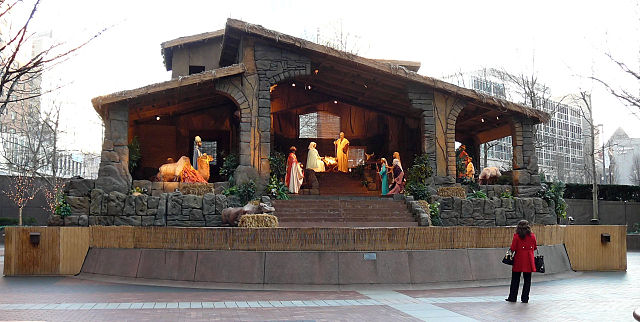Seasonal Displays: Religion and Reindeer
Guest blog by Herbert G. Grey
As the calendar turns over to December, when 97% of Americans celebrate Christmas in some manner, questions invariably arise about the propriety of seasonal displays in public spaces. Many focus on and celebrate the religious significance of Christmas. The thoughts of most turn to “the holidays.” Still others with a “separation of church and state” mindset prefer to sanitize public places from any vestige of religious expression, despite the religious origins of many “holidays.” The variety of these perspectives reveals why we have a First Amendment in the first place. First Amendment law upholding the propriety of seasonal displays on and around government property is fairly well-established. Whether people cherish Christmas or relish the sights and sounds of “the season,” they will find the United States Supreme Court is not a grinch. Those who favor a more strict-separationist, secular perspective under the Establishment Clause can find solace in knowing that seasonal religious expression generally must be accompanied by secular elements or have some underlying historical background or tradition.

The U.S. Steel Creche, December 29, 2006. CC BY-SA 2.5
A LITTLE LEGAL & HISTORICAL BACKGROUND
Protection of Religious Speech. The Supreme Court has consistently said, “Our precedent establishes that private religious speech, far from being a First Amendment orphan, is as fully protected under the Free Speech Clause as secular private expression.” In a later Ten Commandments monument case, the Supreme Court affirmed that there is “no constitutional requirement which makes it necessary for government to be hostile to religion and to throw its weight against efforts to widen the effective scope of religious influence.”
Text, History, and Tradition. It is no secret that religious expression has long been a feature of government proceedings and expression in public spaces. In Church of the Holy Trinity v. United States (1892), the Supreme Court recited dozens of historical examples of religious influence on American government. Most people are familiar with images of crosses at Arlington National Cemetery, cross-shaped war memorials, and Ten Commandment monuments in public places, most of which have been upheld. McCreary County v. ACLU (2005) disallowed a Ten Commandment monument because it had solely a religious purpose in being placed where it was on public property.
“Legislative” prayers to open official proceedings at all levels of government have also been approved as “part of the fabric of our society.” More recently, in Town of Greece v. Galloway (2014), the Supreme Court upheld prayers to open city council meetings based on “tradition” as long as it “does not coerce participation by nonadherents.”
Whose Speech is It? The starting point is to consider whether seasonal displays are private speech or government speech. Since the First Amendment regulates only government restrictions on free exercise of religion or free speech, there is generally no problem with any federal, state, or local government allowing private expression in public places on the same basis as other private speech. At the same time, the Establishment Clause prohibits the federal government (and later state and local governments through the Fourteenth Amendment) from sponsoring or approving one religion- or lack of religion- over another.
The Lemon Test. When the Establishment Clause may come into play, so does the infamous “Lemon test.” Lemon v. Kurtzman (1971) required proof of government action having a secular purpose, a primary effect that “neither advances nor inhibits religion” and not fostering “an excessive government entanglement with religion” to avoid Establishment Clause problems. The Lemon test has been the subject of criticism in the Supreme Court and elsewhere for some time, but it was recently put in the grave for good in Shurtleff v. City of Boston (2022) (the “Boston flagpole” case) and Kennedy v. Bremerton School District (2022).
HOW DOES THIS APPLY TO SEASONAL DISPLAYS?
Since most or all seasonal displays have historically been government-owned and operated, they are typically considered government speech, historically implicating government establishment of religion under the “Lemon test.” Three cases illustrate how the law concerning seasonal displays has developed:
- Lynch v. Donnelly (1984) considered a government display that included a nativity scene, a Santa Claus house, reindeer, a Christmas tree, candy-cane poles, and a “Seasons Greetings” sign. Thus was born the famous “two reindeer” (or “three reindeer”) rule whereby government displays are not impermissibly advancing the Christian religion if they celebrate the “holiday season” by including other secular symbols;
- County of Allegheny v. ACLU (1989) involved a long-time private nativity display owned by a private religious organization on the grand staircase in the county courthouse. The only other private expression given the same opportunity was a Jewish menorah accompanied by other secular symbols. The Supreme Court said that the nativity display violated the Establishment Clause because it featured Christian religious expression and nothing else, but the Jewish display did not violate the Establishment Clause because it included other secular symbols along with religious symbols; and
- Pleasant Grove v. Summum (2009) arose out of a display whereby a city government, over time, allowed multiple privately donated monuments in a public park. The City retained final authority over the displays and had the right to reject others because the existing displays were varied, some were of long-standing origin, and together the displays had religious, historical, and secular components.
CONCLUSION
In an era when diverse views often divide, seasonal displays with religious content represent the essence of the First Amendment as it was intended, an enduring example of bringing people together in some semblance of unity and shared experience for everyone while acknowledging our differences.

About the author
Herbert G. Grey is a lawyer in private practice in Beaverton, Oregon, with over 25 years of experience concerning First Amendment and religious liberty matters. He was admitted to the Oregon State Bar in 1981 and is also admitted to practice before the U.S. District Court for Oregon, the Ninth Circuit Court of Appeals and the United States Supreme Court. He is a member of the Board of Directors of Christian Legal Society and serves as chairperson of the committee overseeing CLS’ Center for Law & Religious Freedom.

